Home

Basic Knots
Advanced Knotwork
Line Treatments
Analysis
Alternative Grids
Further Topics
Sources
Sample Grids
|
Home |
 |
Basic Knots |
Advanced Knotwork |
Line Treatments |
Analysis |
||||
|
Alternative Grids |
Further Topics |
Sources |
Sample Grids |
Celtic artists usually devised patterns in single bands where possible. How was this done?
We see that Celtic knotwork panels (and even whole pages or the sides of carved stones) are often designed to be formed from a single band. For simple interlaces, this only works when the ratio of the number of cell sides has no common factors (for example, in 2 cell X 3 cell templates, 3X4, 5X3, etc. ).
 |
An interlaced 2 cell by 3 cell panel generates a single band. |
 |
A 2 cell by 2 cell panel, when simply interlaced, results in 2 bands. |
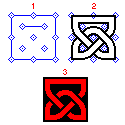 |
The same 2 cell by 2 cell panel, with one added wall, results in 1 band. The first part shows the 2x2 cell grid with the additional "wall" added. The second part shows the band generated by this template with the same rules and methods used in basic interlacing--over and under, changing direction ("turning", or "bouncing off") at walls and in corners. The third shows the band filled in with color. |
The trick is: knowing how to add the "walls" into the panel patterns to end up with a single band in the end.
Most Celtic knotwork designs can be seen either as connected panels (with a side partially removed) or interrupted borders (with extra walls and corners); the two concepts are very similar. The class descriptions use the "panel grid with added walls" interpretation. The original Celtic designers used these breaks and interruptions to develop their striking patterns. They often broke down long rows of border cells into areas like the 2X3 panel above, making designs that cover whole pages (or the sides of standing stones) using one long connected band.
The following example knot is taken from [BainI], pg. 43, using a pattern found in Lindisfarne, especially on Folio 27:
 |
1. It is formed on a 3X5 cell grid with additional cross- shaped walls forming four new corners. |
 |
2. The bands are generated in the same way as for simple interlaced panels, "turning" at corners and walls. |
 |
3. The bands can then be colored in, as with the other panels. For other ways of treating bands, see the section on Line Treatments |
This pattern can be expanded into a border (as in the border pattern below)as well as a panel filling pattern (see the associated Celtic Computer Art pages).
The second example knot panel is also taken from [BainI], pg. 107, using a pattern taken from Lindisfarne, folios 27, 95, and 211:
 |
1. It is formed on a 3X6 cell grid with five additional walls. |
 |
2. The bands are generated in the same way as for simple interlaced panels, "turning" at corners and walls, whether the original panel walls or the added walls. A new feature used here is the longer curve used above the short added wall. Note that the radius of this curve is made to fit "over" the shorter curve--it is not simply two short curves with a straight section between. For a better description of these curve types, see [BainI], Chapter 3. |
 |
3. The bands can then be colored in, as with the other panels. |
This pattern was originally used as a border and was designed to be "mitred" to fit around corners. See the page on Mitred Corners for more information.
The third example knot is a border pattern taken from [BainG], pg. 40 plate E, originally from Kells:
 |
1. The basic pattern is 2 cells wide, repeating every 6 cells, using four additional walls to make two extra unconnected corners. |
 |
2. The bands are generated in the same way as for simple interlaced panels, "turning" at corners and walls, whether the original panel walls or the added walls. This pattern also uses longer curve used above the short added wall. |
 |
3. The bands can then be colored in, as with the other panels. |
Getting border patterns to properly turn corners is fairly tricky--to the best of by knowledge there is no consistent, stereotypical method for generating patterns that properly miter (that is, that turn corners) without drastically changing the underlying patterns, introducing loops or extra bands, etc.
You can try to either "slide" or rotate existing cell patterns into the corner, or try a different pattern that fits better into the corner space. Please expect some very strange bands (even those outside the cell boundaries) when a complex pattern turns a corner!
As an example of a "sliding" pattern, please see the border below (from [Bain] page. 35, plate 10 upper right).
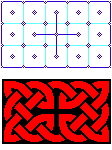
|
1. To the left is the underlying panel template and band treatment, from [BainI], page 43, based on a pattern found in Lindisfarne, Folio 27. |
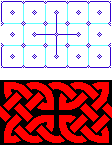
|
2. This figure shows the template extended (by removing parts of the two end walls) to form a border pattern. |
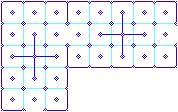 |
3. This figure shows the template shifted and rotated to allow the corner to be turned. Then walls were removed to keep the pattern constant. |
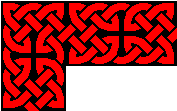 |
4. Finally, the bands were formed and filled in as usual to build the final panel. This can be further rotated and extended to form rectangular mitred panels of any desired size. |
The second example, taken from Kells, shows a template modification allowing the pattern to "turn" a corner.

|
1. To the left is the underlying panel template and band treatment, from [BainI], page 103, based on a pattern found in Kells, Folio 124R. It is a 2X4 cell pattern, with the repeating group offset by a half cell. |

|
2. This figure shows the original template flipped and used in a corner pattern. There is not a smooth way to shift and reconnect the pattern as in the one above. |
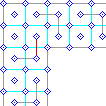 |
3. This figure shows the wall to be removed (in red) to smooth out the corner turn. When doing these on your own, try to not add a loop, but keep the underlying pattern going as much as possible. |
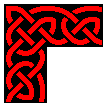 |
4. Finally, the bands are formed and filled in as usual to build the final panel. As with the first example, this can be further rotated and extended to form rectangular mitred panels of any desired size. |
Interlaced panels can be used to fill in areas of a page, like complex borders, between other forms, or inside of large initial caps, etc. The basic design concept is to divide the required space into cells of appropriate scale, and add breaks to make things "interesting" (i.e., single band, no loops, etc.).
The following example approximates the look of Durrow in it's use of knots only on the "carpet" pages (pages with patterns only--not containing text).
 |
1. Divide the required page into cells--in this case into 9 cells by 12 cells. Please note that on a real carpet page the number of cells used would be much greater. |
 |
2. Break down the page into shaped panels. The remainder can be considered a border. A common division included a cross-shaped area (after all, the originals were Gospels, yes?). |
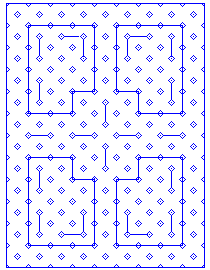 |
3. Add additional "walls" and "corners" to break up the design, add interest, and remove loops. In this design, I managed to get the panels to form a single band, but I failed to do this on the border. |
 |
4. Interlace the border area, using the same techniques as described in the class sections on Basic Interlacing Construction and Advanced Interlacing. |
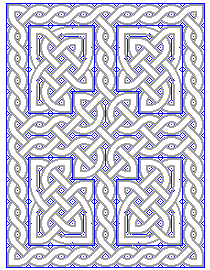 |
5. Interlace the panel areas. In this case I used the same band width throughout, but could have changed it in the border or panels. For information on band width changes, see the class section on Line Treatments. |
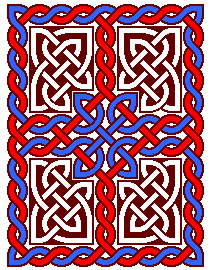 |
6. Finally, color in the bands. I've chosen to use two different band techniques here--one for the panels and a different one for the border areas. Please see the class section on Line Treatments for other ideas on how to decorate the bands. |
You can also use pre-defined panels (see [BainG] or any of the other listed sources), if the area you're trying to fill "factors" properly--that is, if the number of cells filling the space you need to cover is an even multiple of the number of cells in the original pattern. Existing examples used different interlace patterns on different sections of the same page. In fact, some examples use knots, key patterns, zoomorphics, and spiral patterns on the same page.
There are particularly good examples in [Meehan2] (pages 72-102), [BainI] (Chapter 10), [BainG] and, of course, any good facsimiles of the actual manuscripts. A (not terribly good :-) example of a draft SCA-style scroll study using this technique can be seen in the aoa9p1.jpg (81KB) file.
Also, please see other examples of space filling patterns provided on the Celtic "Art" pages.